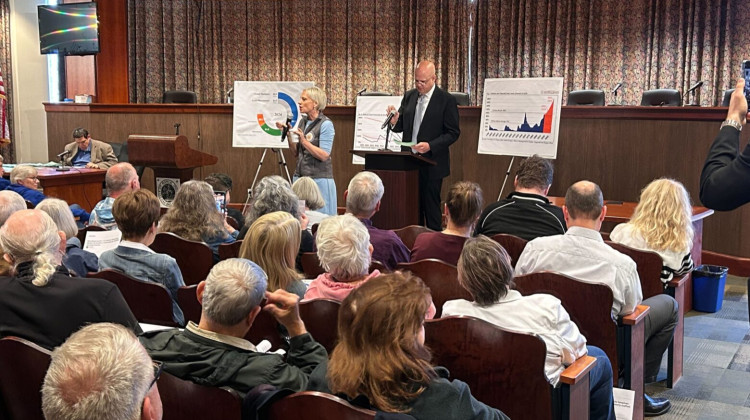
The White River from the Indianapolis Art Center's ArtsPark. Indiana has the most miles of rivers and streams deemed too polluted to swim in of any state.
Eric Schmuttenmaer/Wikimedia CommonsIndiana has the most polluted rivers and streams of any state. That’s according to a new report by the Environmental Integrity Project.
It shows that after 50 years of the Clean Water Act, the U.S. still has a long way to go to protect its waterways.
The Clean Water Act of 1972 was supposed to make all of the waterways in the U.S. fishable and swimmable by 1983 and eliminate water pollution by 1985.
Eric Schaeffer is the executive director of the Environmental Integrity Project. He said that goal was probably too ambitious, but the law did make a difference.
"I lived in the Washington D.C. area as a teenager for several years and you could smell the Potomac [River]. And we lived miles away — you could smell it pretty much every summer day," Schaeffer said.
But after 50 years and more than 120 million people added to the U.S. population, the Environmental Integrity Project report shows about half of the country's rivers, streams, lakes and reservoirs are so polluted that they're deemed "impaired."
Indiana has the most miles of rivers and streams deemed too polluted to swim in of any state. Almost all Indiana's lakes and reservoirs sampled are unfit for drinking water, putting more pressure on the state’s water utilities to remove harmful bacteria like E.coli and toxic algae.
READ MORE: More blue-green algae could drive up drinking water bills in Indiana's larger cities
Schaeffer said the main culprit is manure running off of large animal farms called concentrated animal feeding operations — a type of pollution the Clean Water Act wasn’t designed to handle.
“The law is oriented toward dealing with discharges that come out of pipes that you can see and measure. And that's not typically what you get," Schaeffer said.
Though there are many large livestock farms in Indiana, most of the animals are raised under a contract for just a few major companies — like Tyson and JBS.
“They don't require the big companies to take responsibility for the amount of manure that this kind of factory farm will generate and that's just fundamentally unfair," Schaeffer said.
He said most farmers — even of large farms — don’t have the money to put in the kind of treatment systems needed to keep manure out of local waterways, but those corporations do.
Schaeffer said the Environmental Protection Agency should hold corporations responsible for the problem and regulate these large farms like any other industry.
The Environmental Integrity Project report said state and federal agencies lack the power to enforce pollution controls on "non-point sources" like runoff. And budget cuts to these agencies haven't helped either.
READ MORE: EPA to address slaughterhouse waste causing algae blooms, breeding bacteria
Join the conversation and sign up for the Indiana Two-Way. Text "Indiana" to 73224. Your comments and questions in response to our weekly text help us find the answers you need on statewide issues, including this series on climate change and solutions.
The EPA is also supposed to review pollution control technology standards for industries and update them when better technology comes along. But many of those standards haven't been updated in more than three decades — including for slaughterhouses.
Indiana has monitored more of its rivers and streams in the past decade than many other states. That suggests other states could have more polluted waterways than what the data shows.
Contact reporter Rebecca at rthiele@iu.edu or follow her on Twitter at @beckythiele.
Indiana Environmental reporting is supported by the Environmental Resilience Institute, an Indiana University Grand Challenge project developing Indiana-specific projections and informed responses to problems of environmental change.
9(MDAyMzk1MzA4MDE2MjY3OTY1MjM5ZDJjYQ000))
 DONATE
DONATE






 Support WFYI. We can't do it without you.
Support WFYI. We can't do it without you.